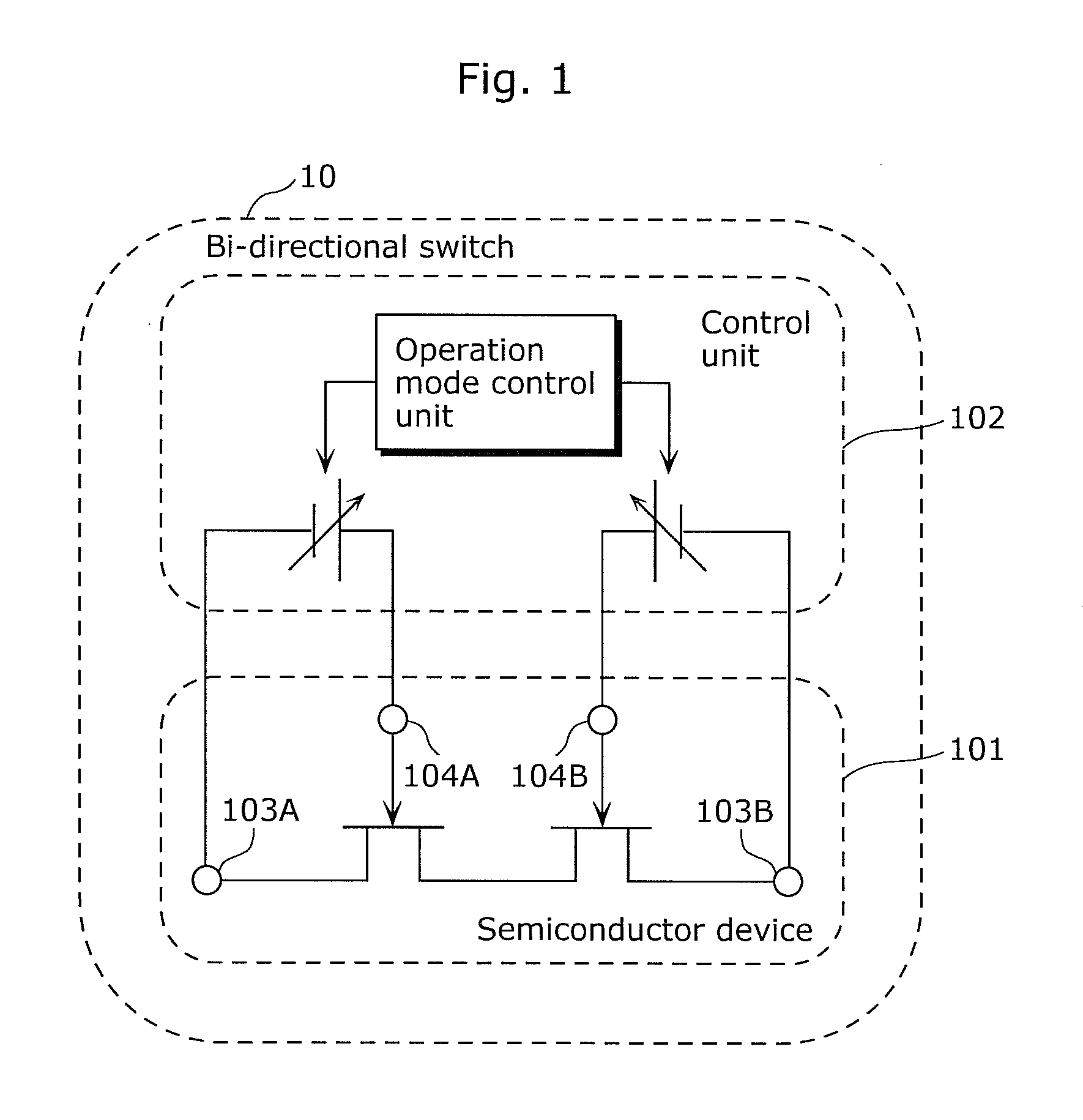Bi-directional switch, alternating-current two-wire switch, switching power source circuit, and method of driving bi-directional switch
a technology of alternating-current two-wire switch and bi-directional switch, which is applied in the direction of electronic switching, pulse generator, pulse technique, etc., can solve the problem of inability to ignore heat, and achieve the effects of reducing conduction losses, low on-resistance, and high mobility
- Summary
- Abstract
- Description
- Claims
- Application Information
AI Technical Summary
Benefits of technology
Problems solved by technology
Method used
Image
Examples
embodiment 1
Variation of Embodiment 1
[0098]Variation of Embodiment 1 is described with reference to the drawings. FIG. 11 is a block diagram showing a structure of a bi-directional switch 10 in this variation of Embodiment 1. FIG. 12 is a cross-sectional view of the semiconductor device 101 in this variation of Embodiment 1. The same structural elements as in Embodiment 1 are assigned with the same numerical references, and no detailed descriptions thereof are repeated.
[0099]As shown in FIG. 12, the semiconductor device 101 according to this variation of Embodiment 1 has a back surface electrode 114 connected to a substrate terminal 115. As shown in FIG. 11, the control unit 102 further includes a substrate potential control unit 102b which controls the potential of the substrate terminal 115 for the semiconductor device 101, in addition to the operation mode control unit 102a which controls the first control terminal 104A and the second control terminal 104B of the semiconductor device 101.
[01...
embodiment 2
Variation of Embodiment 2
[0117]An alternating-current two-wire switch according to Variation of Embodiment 2 is described with reference to the drawings. FIG. 15 is a block diagram of the alternating-current two-wire switch according to Variation of Embodiment 2. In the alternating-current two-wire switch according to this variation of Embodiment 2, the semiconductor device 201 has a back surface electrode 114 connected to a substrate terminal 115. Furthermore, the control unit 202 includes a substrate potential control unit 206 that controls the potential of the substrate terminal 115.
[0118]As with the IS2S1-VS2S1 characteristics of the semiconductor device according to Variation of Embodiment 1, the semiconductor device 201 operates in a state where the on-resistance is large, in the case where a negative voltage is applied as a substrate voltage. Accordingly, it is possible to reduce the amount of an inrush current at the time when the alternating-current two-wire switch is activ...
embodiment 3
Variation of Embodiment 3
[0129]A switching power source circuit according to Embodiment 3 is described with reference to the drawings. FIG. 17 is a block diagram of the switching power source circuit according to Variation of Embodiment 3. In the switching power source circuit according to Variation of Embodiment 3, the semiconductor device 301 has a back surface electrode 114 connected to a substrate terminal 115. Furthermore, the control unit 302 includes a substrate potential control unit 306 that controls the potential of the substrate terminal 115.
[0130]As with the IS2S1-VS2S1 characteristics of the semiconductor device according to Variation of Embodiment 1, the semiconductor device 301 operates in a state where the on-resistance is large, in the case where a negative voltage is applied as a substrate voltage. Accordingly, it is possible to reduce the amount of an inrush current at the time when the switching power source circuit is activated.
[0131]The present invention has be...
PUM
 Login to View More
Login to View More Abstract
Description
Claims
Application Information
 Login to View More
Login to View More - R&D
- Intellectual Property
- Life Sciences
- Materials
- Tech Scout
- Unparalleled Data Quality
- Higher Quality Content
- 60% Fewer Hallucinations
Browse by: Latest US Patents, China's latest patents, Technical Efficacy Thesaurus, Application Domain, Technology Topic, Popular Technical Reports.
© 2025 PatSnap. All rights reserved.Legal|Privacy policy|Modern Slavery Act Transparency Statement|Sitemap|About US| Contact US: help@patsnap.com



